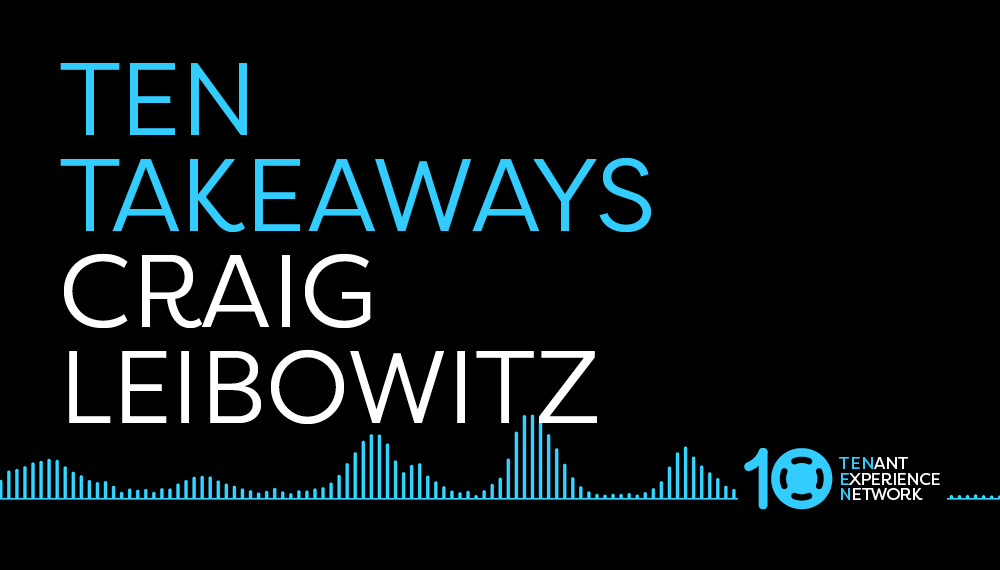
TEN Takeaways from Craig Leibowitz, Executive Director, Innovation and Insight Advisory, U.S. at Avison Young
ICYMI: HILO’s David Abrams hosted Craig Leibowitz, Executive Director, Innovation and Insight Advisory, U.S. at Avison Young to talk about humanizing the real estate story. Here are a few of our takeaways.
It’s not data for data’s sake
When David asked Craig about his unique skill set enabling him to become successful in this industry, Craig shares that his passion for real estate was combined with an understanding of how it’s not data for data’s sake. He says “It’s because data is everywhere. It’s just the interpretation of that data. It is where people like myself and so many of my partners over the years come into play.” The information is out there, but what you do with it can have varying impacts on each organization. Craig also adds that “I could say the availability rate is 19% or say 17%, but at the end of the day, what does it mean for you, you being the client?”
If you can make it in New York, you can make it anywhere
Craig is grateful for the ability to learn from people with unique and interesting backgrounds, who helped supplement his passion for real estate with the exposure and expertise to help him develop his skills as a professional. He shares that he was able to interpret markets through a lens that was unique, explaining that “if you could make it in New York, you could make it more or less anywhere. At least in my warped opinion. I don’t know if that’s exactly true but it enabled me to brand myself through a unique lens and I couldn’t have done that without so many people.”
Unique data enables us to tell the real estate story
David asks all of our guests on TEN what they would do with an additional $100k in budget, and Craig’s answer was to acquire a handful of unique data sources to enable us to tell the real estate story. He says “I think it’s not just vacancy or rents or cap rates, the way that we would traditionally tell the real estate story through an occupier or an investor lens, but I would anchor it more so in real estate. Unique interpretations of demographic trends to name one example. I think that’s where the real opportunity lies in the current environment, because that is what informs decisions and it’s a demand driven environment at the end of the day.”
The war for talent is real
When asked about the implications COVID has had on the multifamily and office sectors, Craig tells David that the war for talent is real: “It didn’t disappear during the pandemic. So I would look at the labor market as a barbell. So on one end of the spectrum, you have an office using appointments. The other end of the spectrum, you have like, pickers, packers, individuals who would work in a warehouse setting, for example, those remain the tightest segments to the labor market today, which is a key differentiator between now and the last couple of recessions specifically, when for example, banks were shutting, head counts and then shutting off the space accordingly. That’s not the case anymore. So the way I would think about it is first and foremost, having some air of flexibility when it relates to returning to the office.”
Account for transition time
Looking back on his time transitioning from working remotely to now working back in the office, Craig shares that time is needed to recalibrate how office workers will be working. “So it’s not as simple as I go back to the office Monday to Friday, turn on a dime you have after Labor Day, you’re back in the office every day. I think there’s a little bit of a transition that comes with that and that’s what worked for me, and I know that what’s worked for others that I’ve spoken to, whether they’re our colleagues or clients. So maybe it’s two days a week, maybe it’s three, maybe it’s four, maybe it’s hey, taking a page out of the American Express playbook and working remotely on Fridays as a start, which is something they’ve done for a long time…So it’s not just turning it on a dime. It’s kind of like a spigot. I would turn it ever so incrementally to get people comfortable returning to the office.”
Comfort is key
While defining and delivering Tenant Experience in 2021 and beyond, Craig believes that “you want your customers, whether they’re renters or office occupiers to simply want to return to the office environment, where they live, whatever it may be.” He continues to look at requirements for disclosures around exposure and paperwork, focusing on making everyone feel comfortable. “I know we had this in New York where I work at a separate line of disclosures for the office building and for the company. And that’s okay, because it made me feel a little bit more comfortable about simply reintegrating the office space. It’s the little things like that that will make a difference”
Office design should be thoughtful
Craig explains that “there have been some studies about the way offices have been configured now, or in the post COVID environment versus the pre COVID environment that could limit people’s exposure to others… And that space isn’t necessarily, the jamming people into communal working environments like sardines, as was the case in the five-year period, preceding the pandemic, at least in markets like New York City, but to deliver a more productive working environment, one in which people feel as though they have the comradery amongst their workforce or opportunities to collaborate in ways that are unique or simply more productive candidly, but also limit their exposure to other perspective or other fellow employees and soon enough to the point you made earlier, clients.”
Humanizing the real estate story
As the title of Craig’s episode suggests, he shares how his company is working on humanizing the real estate story. He says they are “doing it in a way that customizes a message, but delivers real-time and predictive data and data analytics, simple as that. So really what our core focuses on is just simply making the market more transparent because the way most would interpret markets, they’ll say, well, the vacancy here, or the availability rate is X, Y, and Z. Here’s where it was a year ago, but what’s lost in the equation is what does it mean for me? What’s your interpretation of it on my behalf as a trusted advisor.”
- July 16, 2021


